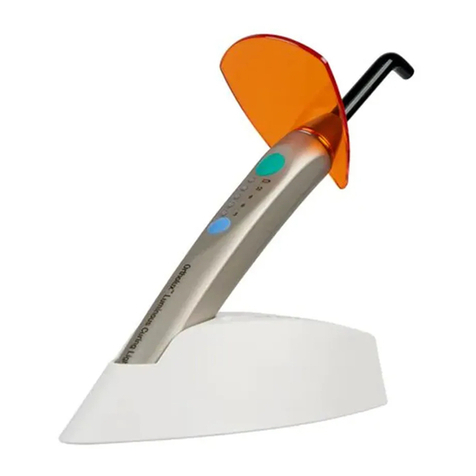3 English
8. Ortholux Luminous Curing Light may be operated
only with the supplied light guide or 3M Unitek
replacement light guide. The light guide has to
be seen as an applied part. The use of other light
guides may result in a reduction or increase in the
light intensity. The product’s warranty does not
cover any damage resulting from the use of third-
party light guides.
9. Condensation resulting from the unit being
transferred from a cold to a warm environment
may be a potential risk. Hence, the unit should be
turned on only after it is completely equilibrated to
ambient temperature.
10. In order to avoid electric shock do not introduce
any objects into the unit with the exception of
replacement parts handled in accordance with the
Instructions for Use.
11. Use only genuine 3M Unitek parts when replacing
defective components as directed in these
Instructions for Use. The product’s warranty does
not cover any damage resulting from the use of
third-party replacement parts.
12. Should you have any reason to suspect the safety
of the unit to be compromised, the unit must be
taken out of operation and labeled accordingly
to prevent third parties from inadvertently
using a possibly defective unit. Safety may be
compromised, e.g., if the unit malfunctions or is
noticeably damaged.
13. Keep solvents, flammable liquids, and sources
of intense heat away from the unit as they may
damage the plastic housing of the charger, the
seals, or the cover on the operating buttons.
14. Do not operate the unit in the proximity of
flammable mixtures.
15. Do not allow cleaning agents to enter the unit as
this may short-circuit the unit or cause potentially
dangerous malfunction.
16. Only service centers authorized by 3M Unitek may
open the unit housing and repair the device.
17.
Ortholux Luminous Curing Light must not be used
for patients, or by users, with heart pacemaker
implants who have been advised to be cautious with
regard to their exposure to small electrical devices.
18. Do not use Ortholux Luminous Curing Light
for patients with a history of photobiological
reactions (including individuals with urticaria
solaris or erythropoetic protoporphyria) or who are
currently on photosensitizing medication (including
8-methoxypsoralen or dimethylchlorotetracycline).
19. Individuals with a history of cataract surgery may
be particularly sensitive to the exposure to light
and should be discouraged from exposure to the
Ortholux Luminous Curing Light unless adequate
safety measures, such as the use of protective
goggles to filter blue light, are undertaken.
20. Individuals with a history of retinal disease should
seek advice from their ophthalmologist prior
to operating the unit. In operating the Ortholux
Luminous Curing Light, this group of individuals
must take extreme care and comply with any and
all safety precautions (including the use of suitable
light-filtering safety goggles).
21. This unit has been developed and tested in
accordance with the relevant EMC regulations
and standards. It is in conformity with legal
requirements. Since various factors such as power
supply, wiring, and the ambient conditions at the
place of operation can affect the EMC properties
of the unit, the possibility that, under unfavorable
conditions, there will be EMC disruptions cannot
be completely excluded. If you should notice
problems in the operation of this or other units,
move the unit to a different location.
22. Prior to each use of the unit ensure that the
emitted light intensity is sufficient to safely
guarantee polymerization. Use the light testing
area integrated into the charger for this purpose.
Glossary of Symbols
Attention, Consult Accompanying Documents
Follow instructions for use.
Type B Equipment -
Protection against electric shock
Class II Equipment - double insulated
Establishes that the product conforms to all
applicable legal requirements
NRTL approval applies only to
USA version PN 704-460
Battery power level
Icon to identify electric and electronic
devices. The unit must be collected and
disposed of separately.
Temperature limitation
Humidity limitation
Atmospheric pressure limitation




























